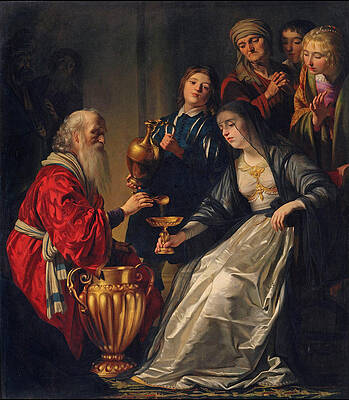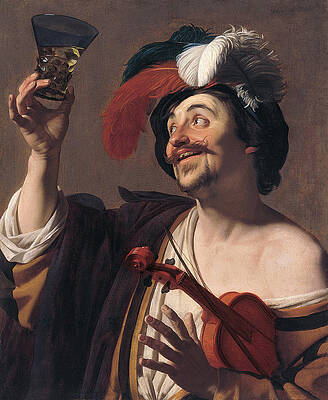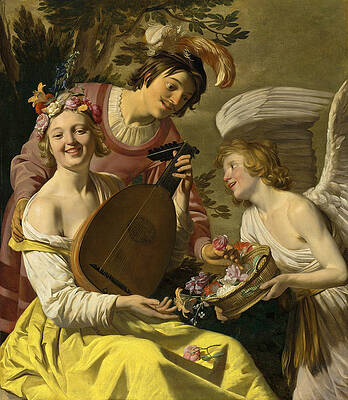Gerard van Honthorst or Gerrit van Honthorst
Paintings
King David Playing the Harp
Saint Sebastian
A Merry Group behind a Balustrade with a Violin and a Lute Player
Nymph and Satyr
The procuress
Musical Group on a Balcony
Portrait of a Lady half length wearing a red cloak
Laughing Violinist
A Woman tuning a Lute
Christ Crowned with Thorns
Adoration of the Shepherds
The Steadfast Philosopher
Elizabeth Stuart. Queen of Bohemia
The flea hunt
Artemisia
The Constancy of Frederik Hendrik
Portrait of a gentleman probably Sir Thomas Aston in a White Lace Collar and Fringed Sash
Christ Crowned with Thorns 2
Merry Violonist
The debarkation of Mary Stuart greeted by Willem II
Shepherd Playing the Flute and four Shepherdesses
Three Children with Fruit and a Jaguar
Allegory of love
Allegory of love
Christ before the High Priest

Elizabeth Stuart, Queen of Bohemia





Frederik Hendrik and Amalia of Solms
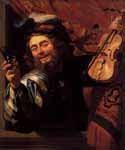


Old Woman Examining a Coin by a Lantern



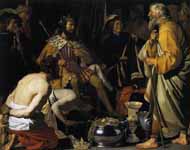

The Happy Violinist with a Glass of Wine







Stadholder Frederik Hendrik, Prince of Orange


Margareta Maria de Roodere and Her Parents
Drawings

Workshop
Putti with Flower Garland
Fine Art Prints | Greeting Cards | Phone Cases | Lifestyle | Face Masks | Men's , Women' Apparel | Home Decor | jigsaw puzzles | Notebooks | Tapestries | ...
King David Playing the Harp
Gerard van Honthorst (Gerrit van Honthorst) (4 November 1592 – 27 April 1656)[1] was a Dutch Golden Age painter. Early in his career he visited Rome, where he had great success painting in a style influenced by Caravaggio. Following his return to the Netherlands he became a leading portrait painter.
Early life
Honthorst was born in Utrecht, the son of au decorative painter, and trained under his father, and then under Abraham Bloemaert.[2]
Italy
Having completed his education, Honthorst went to Italy, where he is first recorded in 1616.[2] He was one of four artists from Utrecht who went to Rome at around this time, all of whom were to be deeply influenced by the recent art they encountered there. The other three were Dirk van Baburen, Hendrick ter Bruggen and Jan van Bijlert.[3] In Rome he lodged at the palace of Vincenzo Giustiniani, where he painted Christ Before the High Priest, now in the National Gallery, London.[2] Giustiniani had an important art collection, and Honthorst was especially influenced by the contemporary artists, notably Caravaggio, Bartolomeo Manfredi and the Carracci. He became especially noted for his depiction of artificially lit scenes, receiving the nickname "Gherardo delle Notti" (Gerard of the night).[1] Cardinal Scipione Borghese became another important patron, securing important commissions for him at San Silvestro Della Mariro, Montecompatri, and at Santa Maria della Vittoria in Rome. He also worked for Cosimo II de' Medici, the Grand Duke of Tuscany.[1]
Return to Utrecht
Honthorst returned to Utrecht in 1620, and went on to build a considerable reputation both in the Dutch Republic and abroad.[2] In 1623, the year of his marriage, he was president of the Guild of St. Luke in Utrecht. He soon became so fashionable that Sir Dudley Carleton, then English envoy at The Hague, recommended his works to the Earl of Arundel and Lord Dorchester. In 1626 Honthorst hosted a dinner for Rubens, and painted him as the honest man sought for and found by Diogenes.
Royal patronage
Queen Elizabeth of Bohemia, sister of Charles I of England and Electress Palatine, then in exile in the Netherlands, commissioned Honthorst as a painter and employed him as a drawing-master for her children.[when?] Through her he became known to Charles, who invited him to England in 1628. There he painted several portraits, and a vast allegory, now at Hampton Court, of Charles and his queen as Diana and Apollo in the clouds receiving the Duke of Buckingham as Mercury and guardian of the King of Bohemia's children. He painted a more intimate group portrait of The Four Eldest Children of the King of Bohemia, (also at Hampton Court) in which the two eldest are depicted as Diana and Apollo.
After his return to Utrecht, Honthorst retained the patronage of the English monarch, painting for him, in 1631, a large picture of the king and queen of Bohemia and all their children. At around the same time he painted some pictures illustrating the Odyssey for Lord Dorchester, and some showing incidents of Danish history for Christian IV of Denmark. He also painted a portrait of the king's daughter Countess Leonora while she was in the Hague.
His popularity in the Netherlands was such that he opened a second studio in the Hague, where he painted portraits of members of the court, and taught drawing.[2] These large studios, where the work included making replicas of Honthorst's royal portraits, employed a large number of pupils and assistants;[2] according to one pupil, Joachim von Sandrart, describing his experiences in the mid-1620s, Honthorst would have about 24 students at any one time, each paying 100 guilders a year for their education.[4]
His brother Willem van Honthorst (1594–1666) was also a portrait painter. Many of Willem's paintings were previously misattributed to Gerrit due to the similarity if their signatures. Willem was a pupil of Abraham Bloemaert, and was also taught by his own elder brother. In 1646 he went to Berlin, where he became court painter to Louise-Henriette, wife of the elector Frederick II of Brandenburg. He returned to Utrecht in 1664.[5]
Legacy
Honthorst was a prolific artist. His most attractive pieces are those in which he cultivates the style of Caravaggio, often tavern scenes with musicians, gamblers and people eating. He had great skill at chiaroscuro, often painting scenes illuminated by a single candle.
Some of his most notable pieces were portraits of the Duke of Buckingham and his family (Hampton Court), the King and Queen of Bohemia (Hanover and Combe Abbey), Marie de Medici (Amsterdam Stadthuis), 1628, the Stadtholders and their Wives (Amsterdam and The Hague), Charles Louis and Rupert, Charles I's nephews (Musée du Louvre, St Petersburg, Combe Abbey and Willin), and Baron Craven (National Portrait Gallery, London). His early style can be seen in the Lute-player (1614) in the Louvre, the Martyrdom of St John in Santa Maria della Scala at Rome, or the Liberation of Peter in the Berlin Museum.
His 1620 The Adoration of the Shepherds in the Uffizi was destroyed in the Via dei Georgofili Massacre of 1993.[6]
Honthorst's 1623 The Concert was purchased for an undisclosed sum by the National Gallery of Art in Washington, D.C., from a private collection in France in November 2013. The painting has not been on view since 1795. The 1.23-by-2.06-metre (4.0 by 6.8 ft) The Concert will go on display for the first time in 218 years in a special installation at the National Gallery of Art's West Building on November 23, 2013. It will remain there for six months before going on permanent display in the museum's Dutch and Flemish galleries.[7]
References
Brown, Beverley Louise, ed. (2001). "Gerrit Hermnsz. van Honthorst". The Genius of Rome 1592-1693. London: Royal Academy of Arts. p. 380.
Brown (1997), p.62
Brown (1997), p.32
Brown (1997), p.46
"James Graham, 1st Marquess of Montrose, 1612–1650. Royalist". National Gallery of Scotland. Retrieved 21 November 2012.
Delavaux, Celine (2012). The Impossible Museum: The Best Art You'll Never See. Prestel. pp. 86–9. ISBN 9783791347158.
Boyle, Katherine. "National Gallery Acquires 'The Concert' by Dutch Golden Age Painter Honthorst." Washington Post. November 22, 2013. Accessed 2013-11-22.
Sources
Public Domain This article incorporates text from a publication now in the public domain: Chisholm, Hugh, ed. (1911). Encyclopædia Britannica (11th ed.). Cambridge University Press.
Brown, Christopher (1997). Utrecht Painters of the Dutch Golden Age. London: National Gallery. ISBN 1-85709-214-7.
Filippo Baldinucci's Artists in biographies by Filippo Baldinucci, 1610–1670, p. 198 Google books
External links
Gerrit-van-honthorst.org Works by Gerrit van Honthorst
Picture gallery at WGA
Reproduction of The Laughing Violinist (French)
Works and literature at PubHist
Vermeer and The Delft School, an exhibition catalog from The Metropolitan Museum of Art (fully available online as PDF), which contains material on Gerard van Honthorst
Dutch and Flemish paintings from the Hermitage, an exhibition catalog from The Metropolitan Museum of Art (fully available online as PDF), which contains material on Gerard van Honthorst (cat. no. 12)
---
Fine Art Prints | Greeting Cards | Phone Cases | Lifestyle | Face Masks | Men's , Women' Apparel | Home Decor | jigsaw puzzles | Notebooks | Tapestries | ...
---
Artist
A - B - C - D - E - F - G - H - I - J - K - L - M -
N - O - P - Q - R - S - T - U - V - W - X - Y - Z
Retrieved from "http://en.wikipedia.org/"
All text is available under the terms of the GNU Free Documentation License

















